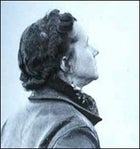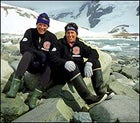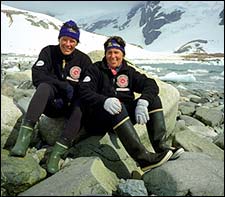Trailblazer Barbara Washburn began exploring the corners of the world in 1940 with her husband, mountaineer Bradford Washburn. In 1947, she became the first woman to summit Alaska’s 20,320-foot Mount McKinley. The Massachusetts-based Washburn, now 89, penned a memoir, The Accidental ���ϳԹ���r, in 2001.
 Rachel Carson
Rachel Carson Lynn Hill
Lynn Hill Ann Bancroft and Liv Arnesen in Antarctica
Ann Bancroft and Liv Arnesen in Antarctica
Journalist and historian Elizabeth Hawley, long considered the definitive source for Himalayan climbing statistics, became Nepal’s first full-time mountaineering correspondent in 1962. Now 80, she still lives in Kathmandu, reporting for Reuters and recording every expedition that comes into the country. She also serves as the executive officer for Sir Edmund Hillary’s Himalayan Trust, which supports health, education, culture, and reforestation in the Mount Everest region.
In 1960, 26-year-old Jane Goodall left Britain for Tanzania to study chimpanzees in the wild. Her subsequent findings—among them, that chimps use tools and have humanlike personalities—revolutionized the world of primatology. Goodall, now 69, runs the Silver Spring, Maryland-based Jane Goodall Institute for Wildlife Research, Education, and Conservation, which she founded in 1977 to promote primate research and wildlife protection.
With the 1962 publication of Silent Spring, an eye-opening bestseller that challenged the safety of agricultural pesticides, Rachel Carson helped jump-start the modern environmental movement. In 1963, she urged Congress to implement protections on the environment and human health, but she died of breast cancer the next year, at age 56, nine years before DDT was banned in the United States.
At the age of 14, Lynne Cox did her first long-distance open-water swim across the 21-mile Catalina Channel in southern California. It was only the beginning. In 1972 and 1973, Cox broke both the men’s and women’s speed records for swimming across the English Channel, and in 1987, she made a historic swim across the Bering Strait, where the water hovers near 38 degrees. Her latest feat: a one-mile swim in the 32-degree waters of Antarctica, completed in late 2002. Cox’s autobiography, Swimming to Antarctica, hits bookstores in January.
On May 16, 1975, Japan’s Junko Tabei became the first woman to summit 29,035-foot Mount Everest. She didn’t stop there—in 1992, she become the first woman to reach the highest peak on every continent. Now 64, Tabei climbs three or four mountains a year and runs the Himalayan ���ϳԹ��� Trust of Japan, an organization dedicated to the preservation of alpine environments.
Inspirational Hawaiian surfer Rell Sunn was known as much for her warmth and free-spirit as she was for pioneering the sport of women’s surfing. Sunn joined the first women’s competitive circuit, the Women’s International Surfing Association, in 1975. She was an expert spear-fisher, free-diver, and outrigger canoeist, and Hawaii’s first full-time female lifeguard. Sunn died after a 15-year battle with breast cancer in 1998, at 47.
Musher Susan Butcher took Alaska by storm in 1988 when she became the first person, male or female, to win the Iditarod dogsled race three years in a row. In 1990 she won a fourth time, completing the grueling 1,150-mile route in a record-setting 11 days. Alaska-based Butcher, now 49, still competes in shorter events.
On June 23, 1986, Polish climber Wanda Rutkiewicz became the first woman to reach the summit of 28,250-foot K2, the second highest mountain in the world. Known to be one of the finest women mountaineers in history, Rutkiewicz was the third woman ever to summit Everest in 1978 and stood on the top of eight of the fourteen highest peaks in the world during her career. In May, 1992, she died at the age of 49, trying to summit her ninth 8,000-meter peak, Kanchenjunga.
For decades, women-specific outdoorwear meant little more than tennis skirts. But itinerant odd-jobber Missy Park changed all that in 1989 when she started Title 9 Sports, believed to be the first mail-order catalog of women’s athletic apparel. Emeryville, California–based Title 9, with a distribution today of 25 million, inspired a generation of similar catalogs and helped convince manufacturers that a core of female athletes and adventurers were out there—and in the market for serious gear.
After four days of climbing, in 1993, Lynn Hill nabbed the first-ever free climb of the Nose, a 3,000-foot, 36-pitch route on Yosemite’s El Capitan. In 1994, she did it again—setting a speed record of 23 hours that still stands. Now 42 and still on the rock, Hill is widely considered the best female climber—if not the best climber, period—in the world.
Wildlife biologist Renée Askins earns props as the driving force behind the 1995 reintroduction of wolves in Yellowstone National Park, a controversial plan that launched wolf restoration and recovery efforts in the southwestern and northeastern United States. After founding the Wyoming-based Wolf Fund in 1986, Askins worked relentlessly to promote the importance of wolves in the ecosystem and to forge a restoration plan acceptable to environmentalists, ranchers, and the National Park Service. Askins is now 44 and living in Wyoming. Her memoir, Shadow Mountain: A Memoir of Wolves, a Woman, and the Wild, was published in 2002.
In February 2001, Ann Bancroft, with Norwegian Liv Arnesen, became the first woman to cross Antarctica on foot—a 94-day, 1,717-mile trip by sail and ski. Forty-eight-year-old Bancroft boasts an all-star résumé: She was the first woman to reach both the North Pole (1986) and the South Pole (1993) on foot. Next up? A 2005 attempt, again with Arnesen, to become the first women to cross the Arctic Ocean by skiing, sailing, and maybe even swimming.
In 1999, UC–Santa Cruz graduate student and amateur surfer Sarah Gerhardt, then 24, became the first woman to ride Mavericks, California’s legendary big-wave break. One of only a handful of female big-wave surfers, Gerhardt joined the ranks of some 50 men who conquered Mavericks’ gnarly 25-foot waves.
On October 9, 2003, 26-year-old French rower Maud Fontenoy arrived in La Coruña, Spain, and claimed her title as the first woman (and eighth person) to row solo across the Atlantic Ocean from west to east. Fontenoy launched her open-ocean odyssey on June 13 in in Saint-Pierre and Miquelon, a group of French islands just south of Newfoundland, Canada, and spent the next 117 days steering her 25-foot boat, Pilot, through brutal storms and waves that towered more than 20 feet above her.


